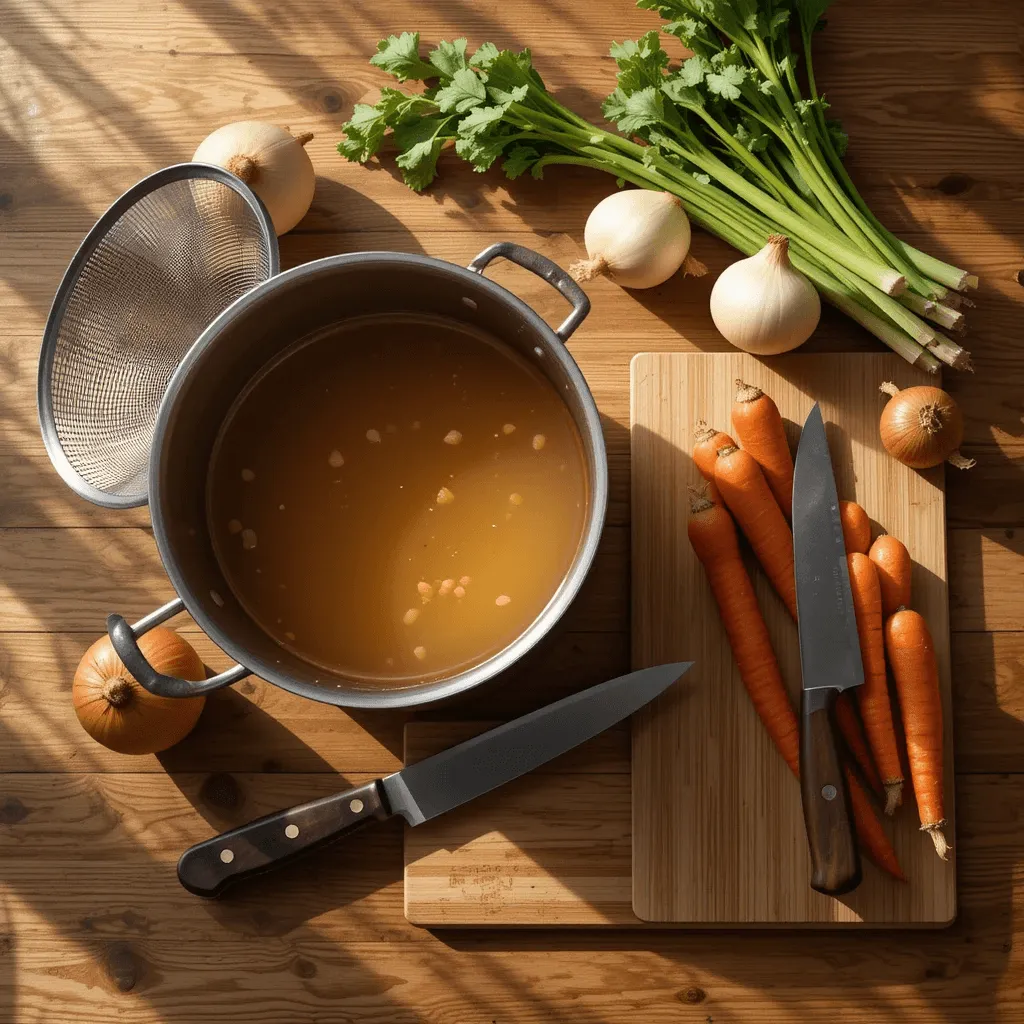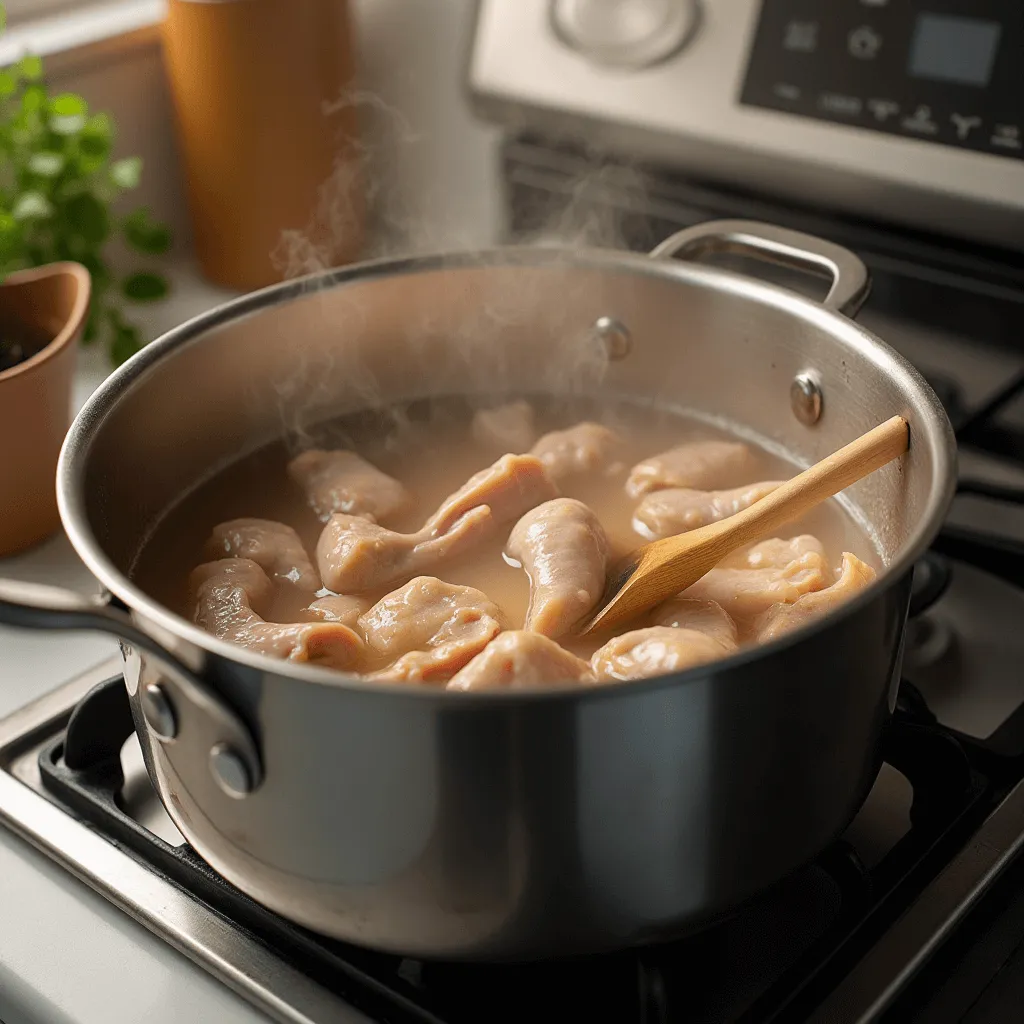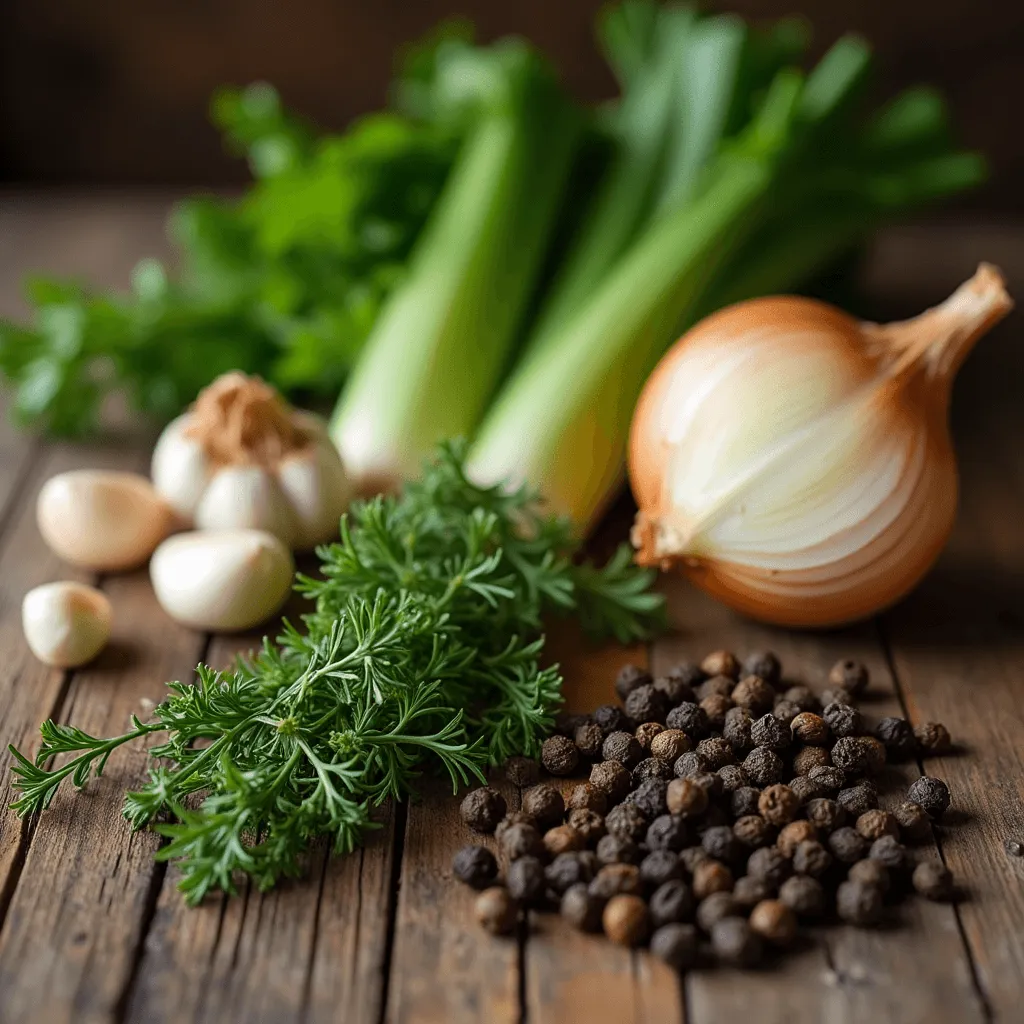Imagine making a tasty and healthy chicken stock from bones at home with just a few ingredients and leftover bones. Learning to make chicken stock from bones can change your cooking game. You’ll control the ingredients, flavor, and nutrition of your homemade broth. This guide will show you how to make a rich, flavorful broth that will make your dishes better.
Making your own chicken stock saves money and lets you customize the flavor. It’s perfect for both seasoned chefs and kitchen beginners. This guide will teach you how to make chicken stock from bones. You’ll learn a valuable skill that will improve your cooking and help you make many delicious dishes.
Table of contents
The Benefits of Making Your Own Chicken Stock
Making your own chicken stock from bones has many advantages. It lets you make a tasty and healthy broth while cutting down on waste and saving cash. You can use leftover bones and veggies to make a nutritious broth, which is both cost-effective and healthy.
One big plus of homemade chicken stock is its amazing taste. Using top-notch ingredients and controlling the cooking, you get a broth that makes your dishes even better. Plus, it’s packed with nutrients like protein, collagen, and more, making it a great choice for your health.
Some of the advantages of making your own chicken stock include:
- Reduced food waste
- Cost-effective cooking
- Superior flavor profile
- Nutritional advantages
In summary, making your own chicken stock is a smart move for your meals. It adds flavor and nutrition, saves money, and reduces waste. It’s clear why many folks choose homemade over store-bought stock.
Essential Equipment for Making Chicken Stock
To make delicious chicken stock, you need the right tools. A large stockpot is key. It lets you simmer the stock for a long time, getting all the flavors and nutrients from the bones. Choose a stockpot with a heavy bottom for even heat and to prevent scorching.
You also need a strainer to remove solids from the stock. Use a fine-mesh strainer or cheesecloth for this. Don’t forget a storage container for cooling and storing the stock in the fridge or freezer. Think about the size and material of your stockpot, as they impact your stock’s quality.
Some key equipment to consider includes:
- A large stockpot with a heavy bottom
- A strainer or cheesecloth
- A storage container
Using the right equipment makes a big difference in your stock’s quality. A good stockpot and strainer lead to a clear, flavorful stock. This is great for soups, stews, and sauces. Invest in the right tools to elevate your cooking and enjoy homemade chicken stock anytime.

Selecting the Right Bones for Your Stock
Choosing the right bones is key to making great chicken stock. The bones you pick will affect the taste and health of your stock. Fresh bones make a light, delicate stock, while roasted bones give a richer taste.
Think about which chicken parts are best for stock. Neck, back, and wings are top choices. They have lots of collagen, which makes the broth rich and gelatinous. This is how your stock gets its magic.
Here are some key points to keep in mind when selecting bones for your stock:
- Neck and back bones are high in collagen, making them perfect for creating a rich and gelatinous broth.
- Wings add a nice balance of flavor and texture to your stock.
- Fresh bones produce a lighter, more delicate stock, while roasted bones result in a richer, more intense flavor.

By considering these factors and selecting the right bones for your stock, you’ll be able to create a delicious and healthy chicken stock that’s perfect for a variety of dishes. Remember, the key is to experiment and find the combination that works best for you, whether that’s using fresh or roasted bones, or a combination of both.
How to Make Chicken Stock from Bones
Starting with a good chicken stock recipe is key. First, rinse the bones under cold water and remove any fat. You can use fresh or roasted bones for different flavors. To make a tasty homemade chicken broth, simmer the bones in water with aromatics and spices.
The simmering time varies from 6 to 24 hours, depending on the flavor you want. Keep the temperature between 160°F and 180°F. You can use a large pot or a slow cooker. Some people use a pressure cooker to speed up the process.
Here are some tips for your chicken stock recipe:
- Use a mix of bone types, such as necks, backs, and wings, for a more complex flavor.
- Add some acidity, like lemon juice or vinegar, to help extract the minerals from the bones.
- Skim the fat that rises to the surface to ensure a clear and flavorful broth.

After simmering, strain the stock and throw away the solids. Cool and store the homemade chicken broth in the fridge or freezer. With a great chicken stock recipe, you can make many tasty dishes, like soups, sauces, and stews.
Aromatics and Seasonings to Enhance Your Stock
When making chicken stock, think about the aromatics that will boost the flavor. Aromatics are key to a great stock. A classic mirepoix combination of onions, carrots, and celery is a good start. It adds depth and aroma to the stock.
Herbs and spices offer endless possibilities. You can mix and match to find your favorite flavor. Thyme, bay leaves, and peppercorns are great choices. Add them to the pot with the aromatics for a rich taste.

- Use a variety of herbs and spices to create a complex flavor profile
- Add aromatics for chicken stock to the pot along with the bones and water
- Simmer the stock for an extended period to extract all the flavors
With the right aromatics, herbs and spices, and mirepoix combination, your chicken stock will be amazing. Be careful with salt and seasoning. You can always add more, but it’s tough to take it away. Follow these tips to make a tasty and aromatic chicken stock.
Simmering Techniques and Timing
Simmering chicken stock means keeping the temperature low, around 180°F to 190°F. This helps the bones and aromatics mix well into the stock. You can use a heavy pot or a slow cooker for this.
The time needed for chicken stock depends on how strong you want the flavor. Simmer for at least 6 hours, or up to 24 hours for a deeper flavor. Always skim off any impurities that rise to the surface to keep the stock clear and tasty.
Here are some tips for simmering chicken stock:
- Use a low heat setting to avoid boiling.
- Skim off impurities regularly to prevent cloudiness.
- Keep an eye on the stock’s temperature to stay within the ideal range.
By following these tips, you can make a delicious and healthy chicken stock. It’s great for soups, stews, or sauces.
Simmering the stock longer makes the flavor stronger. For a more intense stock, simmer for 12 to 24 hours. But, if you’re in a hurry, a 6-hour simmer will also give you a tasty stock. With these techniques and timing, you’ll make a delicious chicken stock.
Straining and Storing Your Homemade Stock
After simmering, it’s key to strain the stock well. This removes solids and impurities, making it clear and flavorful. Use a fine-mesh strainer or cheesecloth to get rid of the solids. This is a vital step in straining chicken stock.
After straining, you can keep the stock in the fridge for up to 5 days or freeze it for 6 months. When storing chicken stock, use containers that keep air out. This prevents bad smells and keeps it fresh. Freezing is also good for keeping the flavor and nutrients.
- Use airtight containers to prevent contamination and spoilage
- Label and date the containers for easy identification
- Store the stock in the refrigerator at a temperature of 40°F (4°C) or below
- Freeze the stock in airtight containers or freezer bags at 0°F (-18°C) or below
By following these tips, you can enjoy your homemade stock for a longer time. Use it as a base for soups, stews, and sauces. Always check the stock for spoilage before using it. If it smells bad or tastes off, throw it away.
Common Mistakes to Avoid
When making chicken stock, it’s key to know common mistakes. These can ruin the flavor, texture, and nutrition of your stock. By avoiding these errors and following some tips, you can make a tasty and healthy base for many dishes.
To steer clear of mistakes, start with high-quality bones. This will give your stock a rich flavor. Then, simmer it for the right amount of time to get all the nutrients and flavors. Strain the stock well to remove any impurities that come up during simmering. These steps will help you make a delicious and healthy chicken stock for your recipes.
Some important chicken stock tips to remember are:
- Use fresh, high-quality bones for the best flavor and nutrition
- Simmer the stock for at least 6-8 hours to extract all the nutrients and flavors
- Strain the stock properly to remove any impurities
- Skim off any impurities that rise to the surface during the simmering process
By avoiding common mistakes and following these tips, you can make a delicious and healthy base for many dishes. Always use the best ingredients and take your time to prepare your stock for the best results.
Different Variations of Chicken Stock
Exploring chicken stock reveals many variations for unique flavors. You can mix different ingredients and methods to create your own stock. Try Asian-style stock with ginger, garlic, and soy sauce, or roasted bone stock by roasting bones first.
Chicken stock offers a chance to be creative and try new recipes. Some favorites include:
- Using a pressure cooker for a quick stock, ready in under an hour
- Adding onions, carrots, and celery for a rich flavor
- Trying herbs and spices for a unique taste
Exploring these variations can broaden your cooking skills and introduce new flavors. Whether it’s a classic chicken stock
Troubleshooting Your Chicken Stock
When making chicken stock, you might run into some common problems. To fix these chicken stock problems, you need to find the cause and act on it. Troubleshooting chicken stock means checking the bones, simmering time, and the aromatics you use.
Some common issues with chicken stock include a lack of flavor, a cloudy texture, or an off smell. To solve these problems, try these steps:
- Check the quality of the bones and replace them if necessary
- Adjust the simmering time to ensure it’s long enough to extract flavors
- Add more aromatics or spices to enhance the flavor
- Strain the stock again to remove any impurities
By following these steps, you can fix troubleshooting chicken stock issues. This way, you’ll make a high-quality stock for your recipes. Always use fresh ingredients and follow the right cooking methods to avoid common issues with your chicken stock.
For more tips on fixing chicken stock problems, look at trusted cooking resources or ask experienced chefs. With practice and patience, you’ll get good at making tasty chicken stock and solving any problems that come up.
Conclusion
Making chicken stock from bones is a simple yet rewarding journey. It can take your cooking to new heights. By making your own chicken broth, you open up a world of possibilities in the kitchen.
This versatile ingredient will become a staple in your cooking. It’s great for hearty soups, stews, rich sauces, and marinades. It will elevate your dishes.
The secret to a superior chicken stock is using high-quality bones. You also need to simmer patiently and strain the broth carefully. By following this guide, you’ll make a rich, aromatic, and flavorful stock.
This stock will transform your cooking. Enjoy the satisfaction of serving homemade dishes full of flavor. Savor the rewards of this time-honored process.
FAQ
What are the benefits of making your own chicken stock from bones?
Making your own chicken stock from bones is cost-effective and tastes better. It’s also healthier because you can control the ingredients. You can save money and reduce waste by using leftover bones and veggies.
What essential equipment do I need to make chicken stock from bones?
You’ll need a big stockpot, a strainer, and a container to store it. A heavy-bottomed pot helps with even heat. Use a strainer to get rid of solids. You’ll also need a container for the cooled stock.
What type of bones should I use for making chicken stock?
The bones you choose affect the stock’s flavor and nutrition. Fresh or roasted bones work well. Neck, back, and wing bones are best for a rich broth.
How do I make chicken stock from bones?
Start by prepping the bones. Then, simmer them in water with aromatics and spices. The simmering time can be 6 to 24 hours. After, strain and cool the stock for storage.
What aromatics and seasonings can I use to enhance my chicken stock?
Aromatics and seasonings add flavor to your stock. Onions, carrots, and celery are a good start. Try herbs and spices like thyme and bay leaves for a unique taste. Use salt and spices carefully, as you can’t remove excess.
How long should I simmer the chicken stock?
The simmering process is key for a flavorful stock. Keep the temperature low and skim off impurities. Aim for at least 6 hours, up to 24 for a stronger flavor.
How do I properly strain and store my homemade chicken stock?
Strain the stock well to remove solids. Use a fine-mesh strainer or cheesecloth. Store it in the fridge for 5 days or freeze for 6 months. Use airtight containers to prevent freezer burn.
What are some common mistakes to avoid when making chicken stock?
Avoid using low-quality bones and not simmering long enough. Strain well to avoid a weak stock. Skim off impurities during simmering.
Are there any variations or alternative methods for making chicken stock?
There are many ways to make chicken stock. Try adding ginger and soy sauce for an Asian flavor. Roasting bones before simmering adds depth. A pressure cooker can make stock in under an hour.
How can I troubleshoot any issues with my homemade chicken stock?
If your stock lacks flavor or has a cloudy texture, check the bones and simmering time. Add more aromatics or spices to improve flavor. Strain again to remove impurities.

